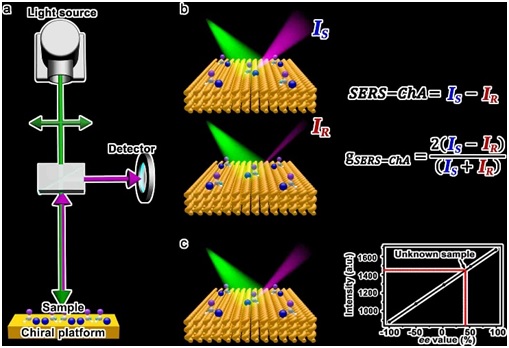Professor Shunai Che's research group has made important progress in enantiomeric discrimination ——Surface enhanced Raman scattering-chiral anisotropy based on chiral nanostructured gold films The qualitative and quantitative detection of chiral molecules is of great significance in analytical science, chemical biology, medicine, pesticide and other fields. However, the traditional spectroscopy and chromatography are limited in the field of enantiomeric discrimination because of low universality, difficult operation and expensive equipment. Therefore, it is still a challenge to find new chiral response theory and detection technology. Professor Che Shunai's group of our school has been committed to the research of new chiral pure inorganic materials, and realizing the recognition and detection of chiral molecules by using various chiral responsiveness of inorganic materials. Recently, Professor Che's research group has published the results of enantiomeric discrimination by surface enhanced Raman scattering-chiral anisotropy (SERS-ChA) of chiral nanostructured gold films in the international top Chemical Journal Angew. Chem. Int. Ed. (2020, doi:10.1002/anie.202006486). Surface enhanced Raman scattering (SERS) is a highly sensitive analytical technique. Due to the strong interaction and radiation enhancement between the molecules and the local electromagnetic field on the surface of the noble metal substrate, this technique can provide ultra-sensitive structural information through the vibration "fingerprint" of trace analytes. SERS-ChA was created by introducing chiral nanostructured Au films (CNAFs) into SERS. Only linearly polarized light (or non-circularly polarized light) is needed to discriminate the enantiomers by SERS intensity of the enantiomers. By drawing the SERS-ChA standard working curve, the quantitative detection of ee value of enantiomers can be realized. Professor Shunai Che's research group worked together with Professor Zhongqun Tan's research group from Xiamen University and Nicholas A. Kotov's research group from University of Michigan in the United States to investigate the generation of chirality and chiral response by characterization of CNAFs. By analogy of the theory and calculation of SERS, it is deduced that the SERS-ChA effect generated through the selective resonance coupling of the electric dipole and magnetic dipole induced by the enantiomers with the CNAFs plasma mode. The local chiral electromagnetic field of CNAFs further selectively enhanced the Raman scattering of the enantiomers, leading to the SERS-ChA effect. 
SERS-ChA is a selective enhancement effect of Raman scattering of enantiomers on the plasmonic metal surface. It is highly sensitive to enantiomers and overcomes the shortcomings of optical rotation system and chromatography. This method is universal for qualitative and quantitative detection of all chiral molecules except internal racemates with only one substrate, and without the demand of sample separation and purification, regardless of molecular size, polarity and chromophore. Prof. Shunai Che is the corresponding author of this paper. Prof. Lu Han, A.P. Yingying Duan, Prof. Songyuan Ding from Xiamen University and Prof. Nicholas A. Kotov from University of Michigan are the co-corresponding authors. Dr. Zexi Liu and Jing Ai from Tongji University are the co-first authors, and Tongji University is the first correspondence organization. Paper Link:https://onlinelibrary.wiley.com/doi/epdf/10.1002/anie.202006486 |
